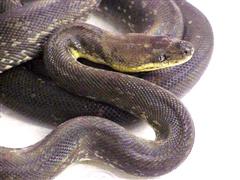Python - Macklot's
Macklots Python, Freckled Python Scientific Name: Liasis mackloti mackloti
Sat, 19th April, 2025 - 5:20 am GMT
Sponsor Ads:

Alternative Name
Macklots Python, Freckled Python Scientific Name: Liasis mackloti macklotiBasic Info
Female Macklot's Pythons are larger than males, usually reaching between seven and eight feet long and 12 to 16 pounds. The males rarely exceed seven feet. The largest specimen of Macklot's Python recorded was over nine feet long. Macklot's Python is characterized by the pale brown heads and yellow throats. Their bodies range from olive to dark brown and have pale speckles, which is where they get the name "Freckled Python." The underside of the snake ranges from pale yellow on the neck to dark brown. Some Macklot's Pythons appear to have darker dorsal surfaces than sides. They often have so many freckles that they appear to be uniformly pale-yellow.
Health
Breeding Macklot's Python breeds best after a brumation period of slightly cooler temperatures (between 79 and 81 degrees Fahrenheit) and very little water. They usually mate between January and February and the eggs hatch in the spring.Habitat
Found in river basins, forests and wet savannahsBehavior
Macklot's Python is a moderately sized python sometimes known as the Freckled Python. They can be rather aggressive, although they often become less so as they mature. Macklot's Pythons are fairly common in captivity, as they are easy to breed. Macklot's Python is native to Indonesia. They spend a lot of time in the water. Macklot's Pythons are very active and can be aggressive. They often become mellower as they age. In the wild, Macklot's Pythons can be found in river basins, forests and wet savannahs.Origin
Indo-PacificHistory
Macklot's Python can be found on various islands in Indonesia, including Timor, Semau, and Roti. Hundreds of Macklot's Pythons are exported from Indonesia yearly. Most of the animals are captured on Timor, from whence they enter the pet trade. Indonesia put a halt to the exportation of these snakes in 1995, and starting in 1996 required any exporters to have a permit to remove the snakes from Indonesia. Because the species is easy to breed in captivity, most specimens of Macklot's Python available to the United States pet trades are captive bred rather than wild caught.Common Foods
They feed primarily on rodents and other small mammals.Sponsor Ads:
Never mistake good manners for good will. -- Unknown
Python - Macklot's
Coded by: BGID® | ALL RIGHTS RESERVED Copyright © 2000-2025
Disclaimer | Privacy | Report Errors / Contact | Credits










